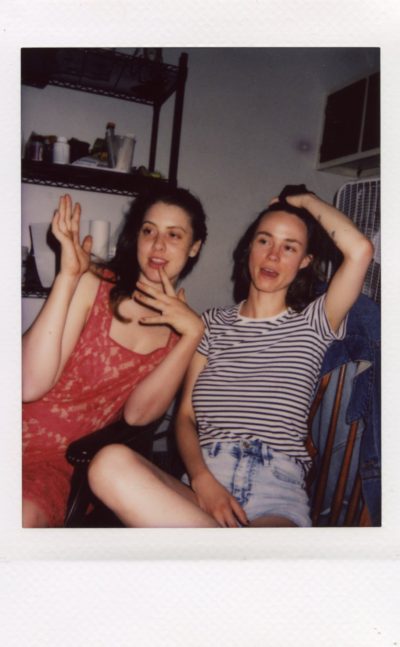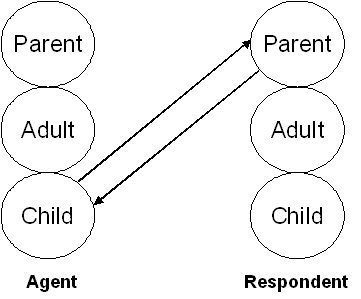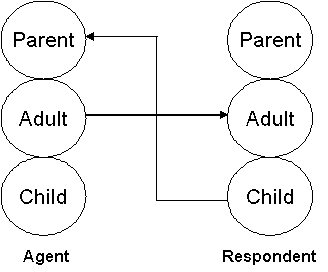Transactional Relationships
March 26, 2020
Text by Rebecca Copper
By Rebecca Copper

Rachael Anderson and Rebecca Copper together in Rachael’s apartment, photo by Left-Handed Sophie (2019).
In conversation with my friend, Rachael, the topics of authenticity and ingenuity often surface. Rachael, who is also an artist, is concerned about the lack of authenticity in the artwork they see as well as in the interactions they observe between individuals. I myself have concern for the lack of humility, humanity, and compassion that I witness in the interactions of people. During one conversation in particular, Rachael labeled these superficial interactions as “transactional”, or a relationship developed with the sole purpose of pursuing a goal, be it an expanded network or financial gain. In the discussion we continued to question how people alter how they behave and who they spend their time with based on this drive to receive something.
Currently, I am pursuing a contemporary practice of art through social practice. What drew me to this kind of artistic practice was an interest in the process of evolution as a focus of art-making in combination with valuing the space that exists in the interaction between individuals. I have worked in this medium for the past few years, but as I become more familiar with the role of the artist in social-cooperative artworks I question: where do these artists sit on a spectrum of substantial relationships and transactional, superficial relationships?
In many socially engaged artworks, the artist acts as an instigator or facilitator working with people or participants. This implies that for the artist’s project to be successful on any scale, there needs to be some kind of engagement from a participant or a number of participants. Therefore, this would categorize the relationships between artist and participant as transactional, seeing as the engagement would benefit the artwork and artist.
From this point, I think it is important to define the terms substantial, superficial, transaction, and relationship. Lexico.com (n.d.), which is powered by the Oxford english dictionary and is often what you’ll find when you Google definitions, defines substantial as “of considerable importance, size, or worth.” Substantial is also defined as “real and tangible rather than imaginary” (Oxford, n.d.). Superficial is defined as “appearing to be true or real only until examined more closely” (Oxford, n.d.). Transaction is defined as, “An instance of buying or selling something; a business deal” (Oxford, n.d.). It is also defined as “An exchange or interaction between people” (Oxford, n.d.). Relationship is defined by the same source as, “the way in which two or more concepts, objects, or people are connected, or the state of being connected”(Oxford, n.d.).
So, I’m left with my next question: are all transactional relationships unsubstantial or superficial? Personally, I usually don’t view things in a strictly binary perspective. I believe there is overlap in all areas of life and that truths blur together to create our very complex layers of experience. From this view, my answer is no. If not all transactional relationships are superficial, what do substantial, transactional relationships look like? Moreover, how does an artist ensure their practice leans more towards genuine and away from superficial transactional? I imagine that in our own web of relationships, examples of substantial, transactional relationships would be things like (but not limited to) parent-child relationships, romantic relationships, and mentor-student relationships.
If we were to create a Venn diagram of transactional relationships, it might look like this:

In researching transactional relationships on the internet, I stumbled across what is called Transactional Analysis. Transactional Analysis is the method of studying interactions between individuals that was developed by Dr. Eric Berne in the 1950s (International Transactional Analysis Association, 2014). Dr. Berne believed that transaction was the fundamental unit of social interaction. He also believed that the ego exists in three states, Parent, Child, and Adult. The Parent state is where an individual replicates behaviors or feelings that mimic what they observed their parents or act out parent-like roles. In the Child state, a person will act out in response through feelings and emotions in a similar way that they would have as a child. The Adult state is the last ego state that an individual exists in. In this state, a person has the ability to evaluate and validate information gathered through the Parent and Child states and to objectively observe reality. Dr. Berne believed that we all interact with one another through transactions with these three ego states.


Here are two diagrams pulled from a website dedicated to Dr. Eric Berne. These diagrams show two different types of ego states interacting, diagrams by Dr. Eric Berne (1964).
In the late 1960’s M.D. Thomas Anthony Harris, a student of Dr. Berne, published the self-help book, I’m Okay – You’re Ok: A Practical Guide to Transactional Analysis (Calcaterra, 2013). This title caught my eye because my husband, who has worked as an environmental education director of a transformational youth camp in the Appalachian foothills of southern Ohio, often referenced this model when working with youth who exemplified emotional responses due to unstable home environments. When a child was acting emotionally unsafe toward themselves or others, Al ,my husband, would say something like, “we need to get to a place where I’m okay and you’re okay. Right now, it looks like you are not okay, how do we get you to where we are both okay?”

Two kids from the youth camp, Camp Oty’okwa in the Hocking Hills of Ohio, photo by Al Marietta (2017)
The model outlined in Dr. Harris’s book consisted of four life positions that were based on Dr. Berne’s psychological set-up in his 1964 book: Games People Play: The Psychology of Human Relationships(Calcaterra, 2013).These four life positions are the following: I’m Not Okay, You’re Okay is the life position where an individual sees themselves in a weaker, unsafe position in comparison to others who they view as strong and more competent. I’m Not Okay, You’re Not Okay is the worst life position where an individual believes there is no hope, they see themselves and the rest of the world in a terrible state. I’m Okay, You’re Not Okay is where a person feels great about themselves but view others as weaker, less competent, or in a bad state. I’m Okay, You’re Okay is the healthiest life position. In this life position, the individual feels confident and good about themselves, and views others as good and competent.
When Faith Moves Mountains was a performance in Lima, Peru in which hundreds of volunteers shoveled a large scale sand dune from one place to another (Kester, 2012). The performance was orchestrated by Francis Alÿs in 2002 and was commissioned for the Lima Biennial. According to Grant Kester, the Los Angeles museum presentation of the performance “focused on the spectacle of the volunteers shoveling the sand” (p.68). He describes an image, “Alÿs, Medina, and Ortega all standing together at the performance site with bullhorns and cameras as they prepare to direct and document the labor of five hundred volunteers, mostly young college students from Lima wearing matching shirts emblazoned with the project logo” (p.69 ).
I would categorize When Faith Moves Mountains as a superficial, less substantial, transactional relationship. The artist instrumentalized and directed 500 people in unpaid, hard labor to create a symbolic gesture for an art audience in which the artist was paid and gained international presence. Furthermore, the volunteers were college students that were bused in to stage a performance that was supposed to criticize labor politics of a place without involving the population (Kester, 2012). “The dune was directly in front of a large shantytown with a population of over seventy thousand immigrants, displaced farmers, and political refugees. Few if any of the residents were involved in the project as volunteers. Instead, the town and it’s population functioned as a kind of backdrop, an image of the political ‘real’ (the impoverished, marginal space left to the victims of development and modernization) against which the metaphoric gesture of fruitless labor could take on added resonance” (p. 71).
I’d like to argue that Alÿs is taking the life position of I’m Okay, You’re Not Okay. Alÿs has assumed a role of power with his bullhorn in hand, dictating volunteers and students in a performance of hard physical work. Meanwhile, ignoring the people of the place that the project is supposed to represent. A perspective can be taken that the volunteers and residents of the nearby town were not left in a place of I’m Okay, where Alÿs left the project with more institutional clout and money. The unpaid volunteers were likely exhausted from shoveling sand for hours and the residents were not given agency but used as a superficial element to Alÿs staging. The ego state interaction which Alÿs falls within is likely one of the following two states: Parent or Child, or maybe a mix of the two. Alÿs mimics the role of a parent instructing the student volunteers, asserting his Parent ego state. Alÿs, also could be fulfilling his Child ego state by emotionally reacting to his poetic imagination or romanticizing the political issues around labor in Lima.
When interacting in the unstable ego states and the three unhealthy life positions previously mentioned, we pursue unsubstantial, transactional relationships. I’d like to push this further to advocate for socially engaged artists to be aware of their own ego states and life positions. If instrumentalization of people or participants is an element of conceptual rigor in a project, ensure that you are aware of it happening and why it is happening.
If you have thoughts, ideas, resources related to my questions and research please write to me OR if you just want to have a conversation :
References
Oxford University. (n.d.). Retrieved January 12, 2020, from https://www.lexico.com/en/definition/substantial
International Transactional Analysis Association. (2014). Retrieved January 12, 2020, from https://www.itaaworld.org/what-transactional-analysis
Description of Transactional Analysis and Games by Dr. Eric Berne MD. (n.d.). Retrieved January 12, 2020, from http://www.ericberne.com/transactional-analysis/
Calcaterra, N. B. (2013). History and impact of the book i’m ok – you’re ok dr. thomas a. harris. Retrieved January 12, 2020, from http://www.drthomasharris.com/im-ok-youre-ok-book-thomas-harris/
Kester, G. H. (2012). The one and the many: contemporary collaborative art in a global context. Durham: Duke University Press.
Rebecca Copper (b.1989) is an interdisciplinary artist that explores the space between symbolic and experiential, dialogical art. She is interested in using dialogue as a medium to shape experiences and as a way to explore collective learning processes. Deeply influenced by the ideas of Fluxus, bell hooks, and writings like the Society of the Spectacle, she supports blurring of art and life while removing hierarchical boundaries that keep art inaccessible. Rebecca has worked with people living in hospice, living under incarceration, as well as youth in some of her socially engaged art projects. She is currently in her first year as an MFA candidate at PSU’s Art and Social Practice Program and is a fellow through the Columbus Printed Arts fellowship. She received her BA from Otterbein University, where she focused on darkroom photography and experimental time-based media of which she pursues alongside her social practice.


